Today, there are hundreds of billions of galaxies, each containing hundreds of billions of stars. And that is just for the observable universe.
Space is really, really big. Not only are stars grouped into galaxies, galaxies are grouped into clusters and clusters into superclusters. Stars in a cluster generally have about the same age and were probably formed from the same nebula. Our galaxy, the Milky Way, is a member of a group — too small to be called a cluster — called the Local Group.
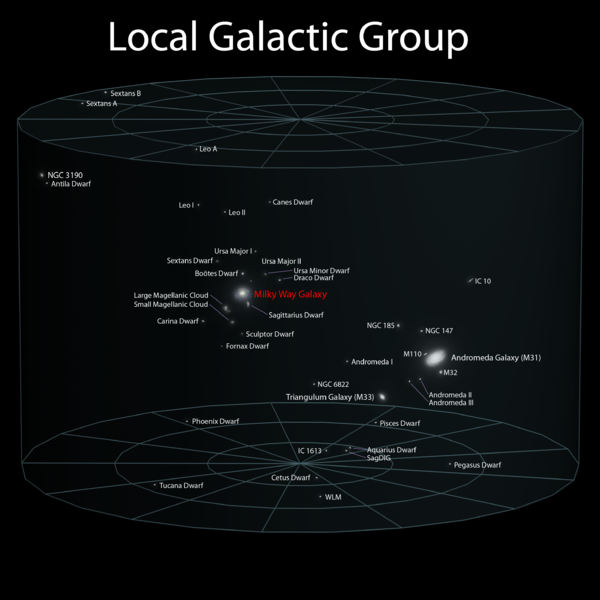
Local galactic group, by Andrew Z. Colvin via Wikimedia
Studies of the large-scale structure of the universe — on scales where galaxy clusters look tiny — indicate that galaxies are spread out in a filament-like structure. It is sometimes compared to soap bubbles, where the galaxies are distributed mainly on the surfaces of the bubbles.
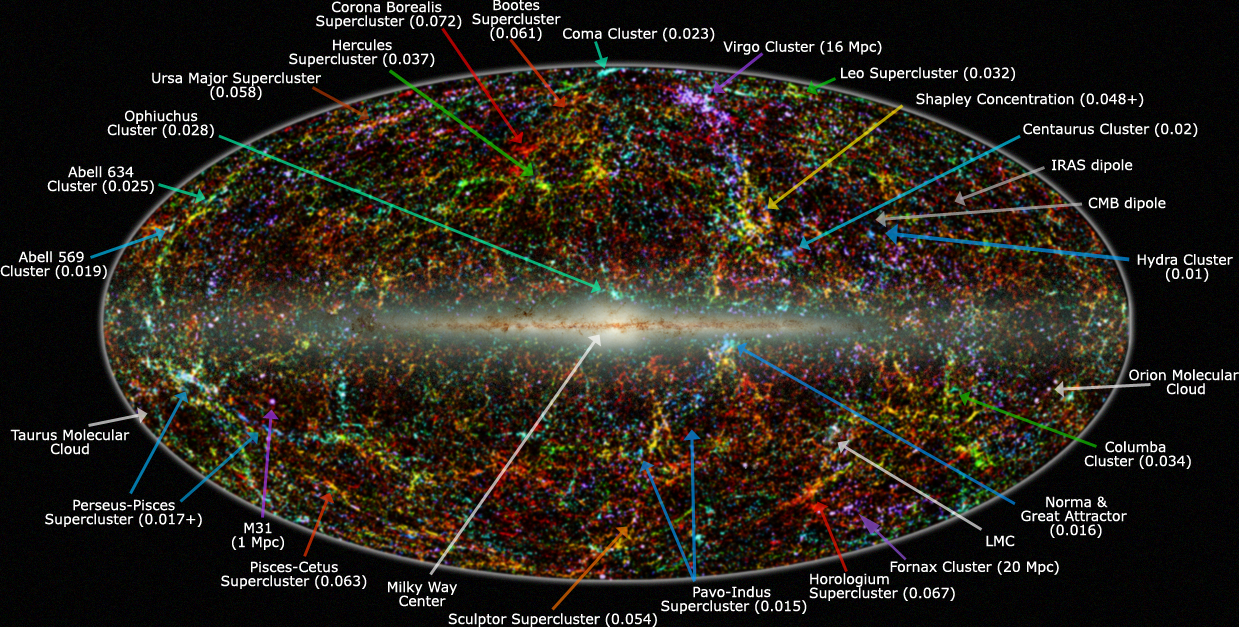
Panoramic view of the entire near-infrared sky reveals the distribution of galaxies beyond the Milky Way. by IPAC/Caltech via Wikimedia.
Although the interior of the “bubbles” is less bright, so that they are also called voids, there are galaxies inside them, including our Local Group.
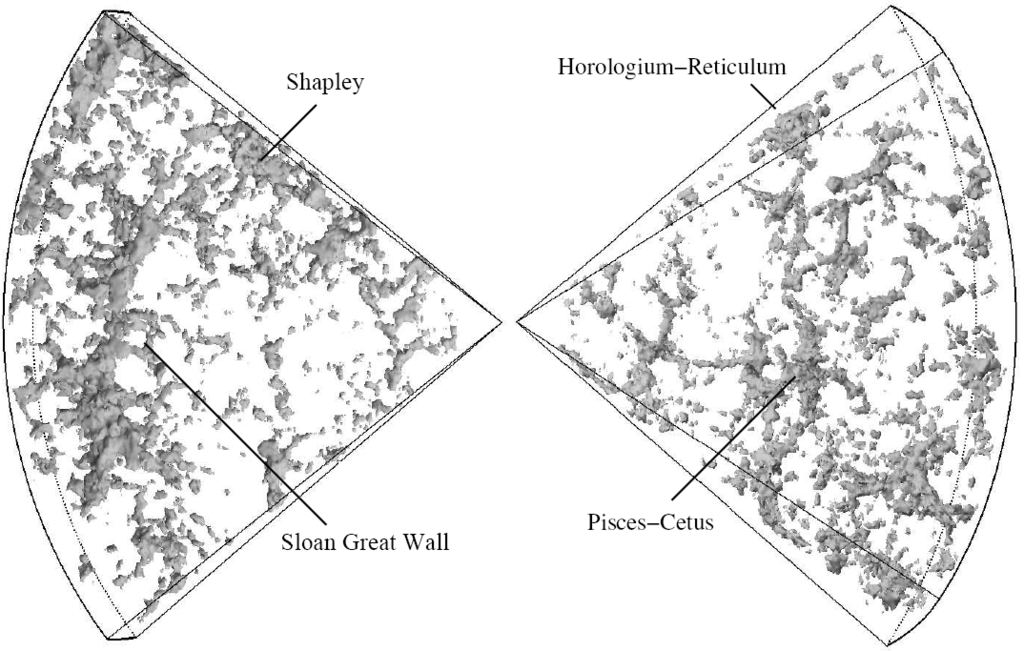
Reconstruction of inner parts of d2f survey by William Schaap via Wikimedia Commons
Large-scale structure and geometry of the universe
Assuming the validity of the Cosmological Principle, that the distribution of objects in the universe is homogeneous and isotropic (the same everywhere and in every direction), the equations of GR have different solutions for the geometry of the universe. These solutions correspond to three possible sorts of curvatures of the universe (in the GR sense).
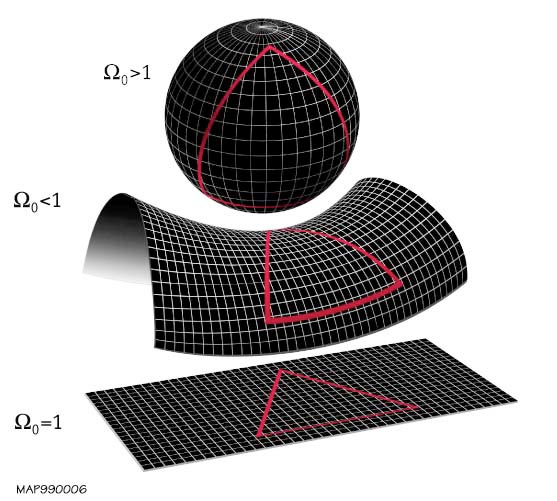
Geometry of the universe, from WMAP via NASA
The geometry depends on a parameter called the critical density of the universe, ρcrit. One often refers to Ω0, the ratio of the observed density to the critical density, .
Ω0 = ρobs/ρcrit.
- Ω0 = 1, means the universe is flat and the sum of the angles of a triangle is 180°.
- Ω0 < 1 means the universe has negative curvature and the sum of the angles of a triangle is less than 180°.
- Ω0 > 1 means the universe has positive curvature and the sum of the angles of a triangle is greater than 180°.
For Ω0 >= (greater than or equal to) 1, space is infinite. If space is infinite now, it always has been, including at the Big Bang. That was indeed the universe in a grain of sand!
Different forms of matter and energy
It is now thought that the universe is composed of three sorts of matter and energy.
Ordinary matter is the classic one and once was thought to be the only kind. This is the matter we are familiar with and which is composed mainly of protons, neutrons and electrons. Contrary to previous ideas, we now know that it only makes up 4.6% of the energy density of the universe1All percentages in this section come from WMAP.. The rest is made up of dark matter and dark energy.
It has been observed that the outer parts of galaxies rotate too fast; the amount of matter in the galaxy is insufficient to generate a gravitational force capable of keeping them from spinning off into space. But dark matter could counteract that centrifugal force. The mass of dark matter provides the gravitational pull needed to hold the galaxy together. Similar phenomena are seen for galaxies in clusters and for the strength of gravitational lensing.2Bending of light waves from a distant star by another star or a planet, like by a lens.
Dark matter must be composed of something which interacts only weakly with ordinary matter and is not visible to us. Other than that, its composition is still unknown. It may be non-baryonic matter left over from the Big Bang. Hypothetical dark-matter particles are referred to as WIMPs, Weakly Interacting Massive Particles. Recent studies suggest several types of such particles.3Astronomers Measure the Density of Dark Matter in Galaxy Clusters. SciTechDaily. Dark matter constitutes 24% of the energy density of the universe.
Dark energy is stranger yet. It has been observed from SNIa red shifts that the expansion rate of the universe has been increasing over about the last 7 billion years. The equations of GR contain what at first seemed an arbitrary constant,4Deemed the Cosmological Constant. which has the interesting – in this case, very handy – property that it causes space to be suffused with a dark energy of negative pressure which exerts a push, not a pull, on matter. After inflation ended, ordinary gravity attracted matter together and slowed down the expansion. But expansion continued nonetheless. As matter became more diffuse in space, gravity was no longer a match for the dark-energy pressure, which is thought to be a property of space and so is constant and not diluted. Since about the time the universe celebrated its 7 billionth birthday, the dark-energy push has been stronger than the attraction of gravity and the expansion of the universe has accelerated. Dark energy has been calculated to furnish 71.4% of the energy density of the universe. Almost amazingly, this is just the total energy density required in order for Ω0 to be approximately equal to 15WMAP finds a value of 1.02+-0.02. so that the universe is “flat”.
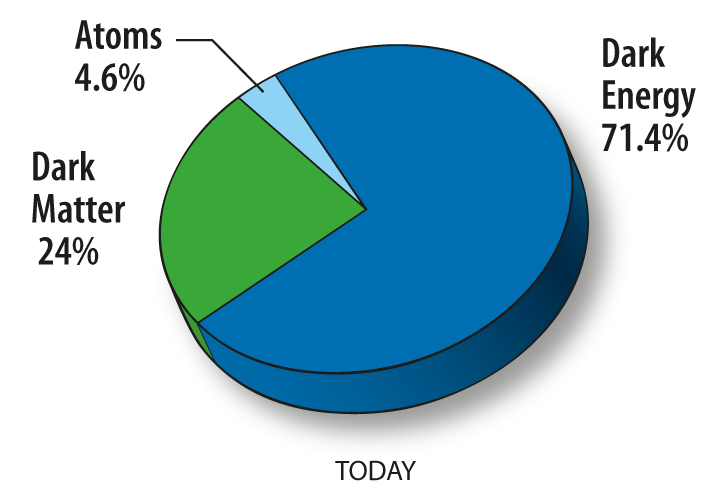
Universe makeup pie chart, from WMAP via NASA
The bad news is that theoretical calculations of the constant come up with a value far, far too large to be true. Work continues.
In summary, dark matters attracts and can be diluted by the expansion of space. Dark energy repulses and never dilutes.
It is quite astonishing that only of 4.6% of the
Formation of our solar system
About 10 Gya, a new protostar formed in the outer fringe of the the galaxy we call the Milky Way. The agglomeration of dust was probably initiated by shock waves from a nearby exploding supernova. The protostar was turning, and since the centrifugal force was greatest in the plane perpendicular to the axis of rotation, matter surrounding the forming Sun was compressed into a flat disk of dust formed around the big lump in the middle. Increased density meant increased pressure and, therefore, temperature. The lump condensed further and became the proto-Sun. The matter in the disk also clumped together into rotating chunks. Some of these had diameters of 1 km or so and are called planetesimals. The passage from a cloud of dust and gas to a star surrounded by planetesimals probably only took about ten million years6McDougall (2011), 29..The largest of these chunks formed the planets; the other, smaller pieces, became asteroids and comets. Heavier elements like iron and silica were held by the Sun’s gravity and so formed the closer planetesimals which would become the four rocky planets – Mercury, Venus, Earth and Mars. Lighter gases like hydrogen and helium were volatilized by the heat and blown farther out by the solar wind and came to form the giant gas planets, Jupiter, Saturn, Uranus and Neptune. When the centrifugal force of their motion around the Sun balanced out gravity, they were maintained in elliptical orbits at nearly constant radial distances7Elliptical radii, major and minor, to be sure. from the Sun. Slowly, the protoplanets swept their orbits clean, merging the encountered rocks with each one’s surface. The subsequent history of the Earth is the subject of geology and so the next chapter.
Future of the solar system and the universe
According to currently prevailing cosmological theory, the ultimate state of the universe is quite literally not bright. There are minority opinions to the contrary.
As we have seen, in 5 billion or so years, the Sun will flare up into a red giant and engulf the Earth, including us, unless we can escape to another solar system, a voyage of at least several generations. But even that would be a temporary respite. Meanwhile, our solar system finally
On a broader scale, galaxies will disperse as stars explode into dust floating throughout expanding space-time. As the universe goes on expanding under the impulsion of Dark Energy, the dust eventually will be too diffuse for another star to form from it under the pull of gravity. The universe will then become a thin “soup” of particles diffused randomly throughout an enormous and ever-expanding void. The expansion of space will prevent any communication between celestial objects.8This does not violate Special Relativity. It is not a signal moving faster than light, it is space expanding. Besides, how does one define velocity in expanding space…? There will be only cold and darkness, with no starlight to warm and delight us and no “us” there to be warmed or delighted. It will be totally silent, not a bird will sing, nor a cat meow. “The Big Freeze”.9This will be the fate of the universe if it is indeed flat, as is now thought. If the energy density is greater than it is thought to be, then the universe may eventually collapse back onto itself in a “Big Crunch”. Feel better?
Nevertheless, the understanding of the universe around us underscores and nourishes our astonished appreciation of its beauty. The knowledge that time for life and beauty, although vast, is limited can remind us to appreciate that we are here now – once – so it is our only chance to make the best possible use of our limited lifetimes – individual or collective. Perhaps we even will manage develop ways of living which will leave the billions of years of life still left on Earth a place pleasing to our descendants – whatever they may be.
So much for cosmology. On to read about what geology tells us.
Notes
| ↑1 | All percentages in this section come from WMAP. |
|---|---|
| ↑2 | Bending of light waves from a distant star by another star or a planet, like by a lens. |
| ↑3 | Astronomers Measure the Density of Dark Matter in Galaxy Clusters. SciTechDaily. |
| ↑4 | Deemed the Cosmological Constant. |
| ↑5 | WMAP finds a value of 1.02+-0.02. |
| ↑6 | McDougall (2011), 29. |
| ↑7 | Elliptical radii, major and minor, to be sure. |
| ↑8 | This does not violate Special Relativity. It is not a signal moving faster than light, it is space expanding. Besides, how does one define velocity in expanding space…? |
| ↑9 | This will be the fate of the universe if it is indeed flat, as is now thought. If the energy density is greater than it is thought to be, then the universe may eventually collapse back onto itself in a “Big Crunch”. Feel better? |


